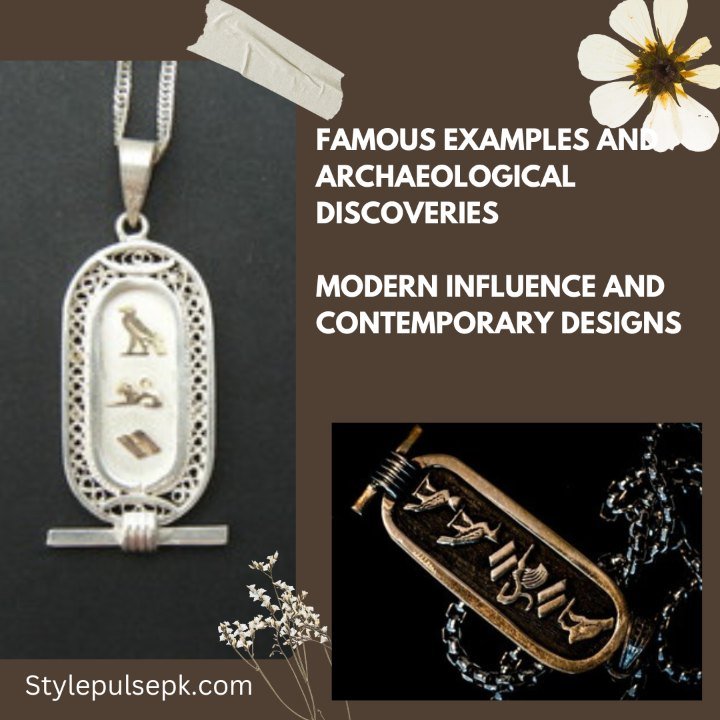The Best Egyptian Jewelry
haris ch
- January 27, 2024
- 10 min read

Table of Contents
ToggleIntroduction
Welcome to the fascinating universe of Egyptian gems, where each dazzling piece portrays a story of old craftsmanship, significant imagery, and rich social legacy. Go along with us on an entrancing trip through time as we disentangle the charm and facade of Egyptian enhancements, traversing hundreds of years of creative imagination and immortal tastefulness.

Historical Context
Old Egypt, prestigious for its arrogance and complexity, regarded gems as an image of status, otherworldliness, and cultural importance. From the most reduced worker to the mightiest pharaoh, gems enhanced people across all layers of society, created carefully from excessive materials like brilliant gold, heavenly lapis lazuli, and valuable gemstones, each piece a demonstration of the plushness and refinement of old Egyptian development.
Egyptian jewelry holds a rich verifiable setting, profoundly interlaced with the culture, beliefs, and societal structure of ancient Egypt. Here is an outline:
1.Ancient Egypt’s Long History: Egyptian progress crossed north of three centuries, from around 3100 BCE to 332 BCE. All through this period, jewelry assumed a huge part in both strict and mainstream settings.
2.Symbolism and Beliefs: jewelry in old Egypt wasn’t only for decoration; it held significant representative importance. Certain materials and plans were related with specific divine beings, divinities, or strict convictions. For instance, the scarab creepy crawly represented resurrection and recovery, while the ankh addressed life.
3.Materials: Old Egyptians involved various materials for their gems, including gold, silver, valuable stones like lapis lazuli and turquoise, as well as semi-valuable stones, faience, glass, and, surprisingly, humble materials like earth and wood.
4.Societal position and Riches: gems were similarly a marker of monetary prosperity and overflow. The quality and measure of pearls worn much of the time reflected a singular’s situation in the public eye. Pharaohs and blue-bloods improved themselves richly with perplexing enhancements made of important metals and gemstones.
5.Funerary Practices: jewelry played huge parts in Egyptian funerary practices. Well off people were frequently covered with their jewelry, accepting it would go with them to eternity. The popular entombment fortunes of Tutankhamen, for example, incorporated a plenty of gems things.
6.Craftsmanship: Egyptian adornments were created with wonderful ability and accuracy. Artisans utilized procedures like fastening, granulation, filigree, and cloisonné to make unpredictable plans. Many enduring pieces exhibit excellent craftsmanship, displaying the authority of old Egyptian artisans
7.Amulets and Talismans: Past tasteful allure, jewelry frequently filled defensive or mysterious needs. Special necklaces and charms were regularly worn to avert malicious spirits, safeguard the wearer from hurt, or bring favorable luck.
8.Impact of Unfamiliar Societies: Over Egypt’s time, communications with unfamiliar societies, like the Greeks, Romans, and Persians, affected the styles and materials utilized in Egyptian jewelry. This is especially obvious in the later times of Egyptian history.
9.Archeological Importance: The disclosure of Egyptian jewelry in archeological excavations has given significant experiences into antiquated Egyptian culture, including their convictions, customs, and mechanical progressions in metallurgy and adornments making methods.
Meaning and Symbolism

Egyptian adornments rose above simple ornamentation, saturated with layers of significant imagery and ghostly importance. Necklaces and amulets were adorned with the Ankh, a powerful talisman of divine protection and continuity, a timeless symbol of eternal life. The Scarab, worshipped as an image of revival and strength, enhanced illustrious formal attire and ordinary talismans, demonstrating the everlasting pattern of life and passing. Similarly, the Eye of Horus, an image of heavenly insight and security, graced rings and pendants, presenting to wearers the endowments of infinite congruity and otherworldly knowledge.
Egyptian jewelry held significant importance and imagery inside antiquated Egyptian culture, mirroring their strict convictions, economic wellbeing, and social qualities. Here is a more profound plunge into the implications and imagery of Egyptian gems:
1.Religious Symbolism: Much of Egyptian gems was permeated with strict importance. Certain images and themes were related with divine beings and goddesses, addressing parts of the heavenly domain. For example:
- The ankh image addressed life and interminability, frequently worn as a talisman to give insurance and endowments.
- The Eye of Horus represented security, wellbeing, and heavenly power. It was ordinarily utilized in adornments to summon the endowments of Horus, the sky god.
- The scarab creepy crawly represented resurrection and recovery, mirroring the faith in the hereafter and the excursion of the soul.
2.Protection and Amulets: Many pieces of Egyptian gems served defensive capabilities, going about as ornaments to avert malicious spirits, ailment, and mishap. Talismans as divine beings, creatures, and images were worn as pendants or integrated into gems plans to give profound security to the wearer.
3.Social Status and Identity: Jewelry was frequently used to mean economic wellbeing, riches, and character inside Egyptian culture. The quality and amount of gems worn by an individual mirrored their position, with pharaohs and aristocrats embellishing themselves with the most rich and elaborate pieces.
4.Funerary Rituals: Jewelry played a critical part in Egyptian funerary practices. Well off people were frequently covered with a variety of adornments things, accepted to go with them to the hereafter and serve them in the domain of the divine beings. These entombment treasures included ornaments, accessories, wristbands, rings, and different enhancements.
5.Materials and Colors: The selection of materials and varieties in Egyptian gems held representative importance. Gold, thought about the tissue of the divine beings, was the most valuable metal and represented time everlasting and heavenly power. Blue and green stones like lapis lazuli, turquoise, and faience addressed the shades of the sky and the Nile, representing life, richness, and resurrection.
6.Cosmic Symbolism: Some gems plans were roused by enormous themes, mirroring the old Egyptians’ interest with divine bodies and the universe. Images, for example, the sun plate, moon bow, and stars were integrated into gems to bring out grandiose powers and divine divinities.
7.Love and Warmth: Adornments was likewise traded as badge of adoration and friendship. Couples traded rings and talismans with heartfelt engravings or images addressing adoration, constancy, and solidarity.
Types of Egyptian Gems

In the celebrated domain of old Egypt, gems appeared in a stunning cluster of structures and works, each piece fastidiously created to embellish and enable its wearer. Elaborate collars embellished the necks of eminence, their unpredictable plans representing inestimable request and majestic power. Fragile arm bands covered the wrists of aristocrats, their sparkling magnificence mirroring the effortlessness and refinement of Egyptian culture. Rings and special necklaces, created with fastidious accuracy, filled in as charms of security and success, while studs and ear decorations encapsulated the Egyptians’ veneration for excellence and enhancement, their elegant structures repeating the rhythms of the regular world.
Egyptian jewelry enveloped a wide cluster of types, each with its own special style, reason, and importance. Here are the absolute most eminent sorts of Egyptian jewelry:
1.Necklaces: Neckbands were among the most well-known sorts of adornments worn by all kinds of people in antiquated Egypt. They came in different styles, lengths, and materials, going from basic beaded strands to expound collars and pectorals embellished with valuable metals and gemstones. Accessories frequently highlighted ornaments, images, and defensive charms.
2.Bracelets and Anklets: Arm bands and anklets were well known embellishments worn by the two sexes. They could be straightforward groups or unpredictably created sleeves, in some cases highlighting engraved plans, trims, or hanging charms. These pieces were in many cases worn in products, stacked on the wrists or lower legs for a layered look.
3.Earrings: Hoops were worn by all kinds of people in antiquated Egypt, in spite of the fact that they were all the more usually connected with ladies. Egyptian hoops came in different styles, including studs, loops, and hanging plans. They were frequently enhanced with representative themes, for example, lotus blossoms, consecrated creatures, or defensive images like the Eye of Horus.
4.Rings: Rings were worn as brightening embellishments and images of status and authority. They were normally made of gold or silver and could include perplexing plans, engraved engravings, or inset gemstones. Rings were likewise traded as badge of adoration and responsibility between couples.
5.Special necklaces and Charms: Ornaments and charms held extraordinary importance in Egyptian culture and were frequently worn as gems for security and favorable luck. These little charms came in different shapes and structures, including portrayals of divine beings and goddesses, hallowed creatures like the scarab bug, and images, for example, the ankh and the Eye of Horus.
6.Crowns and Diadems: Eminence and high-positioning authorities frequently wore elaborate crowns and diadems as images of their power and heavenly status. These crowns were ordinarily made of gold and decorated with valuable gemstones, mind boggling filigree work, and representative themes addressing the ruler’s association with the divine beings.
7.Pectorals and Chest Trimmings: Pectorals were fancy breastplates worn across the chest by pharaohs and high-positioning authorities during strict functions and significant ceremonies. These intricate pieces were frequently made of gold and enhanced with mind boggling plans, hieroglyphic engravings, and representative themes addressing heavenly insurance and power.
8.Armlets and Arm Groups: Armlets and arm groups were worn around the upper arm as enlivening enhancements. They could be straightforward groups or more intricate sleeves enhanced with engraved plans, decorates, or hanging charms. These pieces were much of the time worn by all kinds of people and were related with tastefulness and status.
Famous Examples and Archaeological Discoveries

The fortunes of Tutankhamen, uncovered from the hallowed profundities of the Valley of the Lords, offer an enticing look into the quality and refinement of old Egyptian gems. Gold demise veils, shining pectorals, and fancy ornaments embellished the youthful pharaoh’s funerary chamber, their impeccable craftsmanship and emblematic importance confirming the Egyptians’ immovable confidence in the hereafter and the timeless excursion of the spirit. Additionally, the amazing gems of Cleopatra, famous sovereign of Egypt, spellbound the hearts and minds of admirers all through the ages, their immortal polish and great charm typifying the embodiment of Egyptian persona and appeal.
Modern Influence and Contemporary Designs
The persevering through tradition of Egyptian adornments proceeds to move and spellbind contemporary architects and style fans around the world. From high fashion runways to mixed craftsman stores, Egyptian themes and plans inject current gems with a feeling of immortal tastefulness and social sound. From smooth moderate understandings to lavish evangelist styles, Egyptian-enlivened gems rises above patterns and trends, exemplifying the getting through soul of old Egypt in an energetic embroidery of structure and capability.
Buying Guide and Shopping Tips
Exploring the confounded commercial center of Egyptian-enlivened gems can be an overwhelming undertaking for the unenlightened. It is essential to take into consideration aspects such as the authenticity of the materials used, the level of craftsmanship, and ethical sourcing when looking to acquire authentic items that are infused with the spirit of ancient Egypt. Search out legitimate dealers and craftsman’s who maintain the best expectations of honesty and quality, guaranteeing that your buy praises the tradition of old Egypt as well as supports feasible practices and fair exchange standards.
Conclusion:
As we close our odyssey through the charming domain of Egyptian adornments, we are helped to remember its persevering through advance and immortal importance in the chronicles of mankind’s set of experiences. Egyptian jewelry continues to captivate and inspire generations of fans worldwide, from the splendor of pharaonic treasures to the elegance of contemporary interpretations. As we decorate ourselves with these flawless fortunes, we give proper respect to an old inheritance that rises above existence, winding around together the strings of human imagination, otherworldliness, and social legacy in embroidery of excellence and significance.











